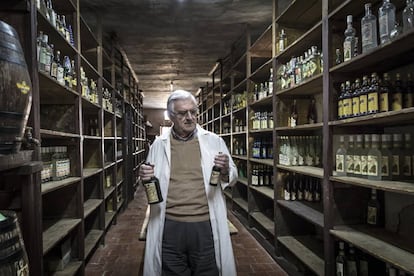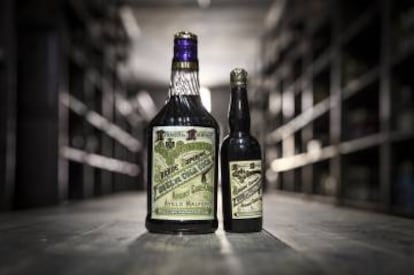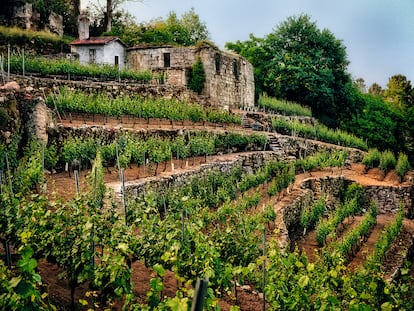Valencia village lays claim to original Coca-Cola recipe
The world’s most famous soft drink was supposedly first concocted in a small town in eastern Spain


The recipe for Kola-coca is languishing in a safe inside the office of 79-year-old Juan Juan Micó, who owns Destilerías Ayelo, in the village of of Aielo de Malferit, in Spain’s Valencia province. After ensuring no photos will be taken, the elderly gentleman unlocks the box and extracts the notebook in which the secret formula is inscribed.
Rather than an alternative version of the world’s most famous soft drink, Kola-coca is in fact the precursor to Coca-Cola, or so says not just Juan, but also local authorities in Aielo de Malferit and most of its 4,706 inhabitants. In fact, local officials have written to the multinational, asking permission to publicly explain the connection.
While Coca-Cola became the world’s favorite fizzy drink, Kola-coca went out of production
There is, of course, no concrete proof that Coca-Cola began life in Aielo. But for generations, the people here have believed that the syrup that John Pemberton used in Coca-Cola was originally concocted by the local distillery.
“Everything points to this being the case,” says the town’s mayor, José Luis Pinter. “Our aim is to get Coca-Cola to acknowledge the project so that the town will get recognition. We’re not seeking anything more than that.”
While there is a mythical quality to Aielo’s claim, there are plenty of facts to support the tale. For example, 138 years ago, three local entrepreneurs, Enrique Ortiz, Ricardo Sanz and Bautista Aparici, opened a distillery in town. Aielo was then half its current size, but it was on the map as a producer of liqueurs and American vines, which are still cultivated here and sold in wine-making regions such as La Rioja.
To illustrate its importance at the time, Juan pulls out a document dated 1892 in which Maria Cristina of Austria, who was then ruling Spain as regent, bestowed the title of royal provider on the distillery, allowing it to use the royal crest on its labels and accounts.

The walls of the distillery still bear the remains of the ostentatious wallpaper that adorned it during that glorious era, along with diplomas certifying participation in events that took place more than 100 years ago in Rome, Turin, Brussels, Paris, Bordeaux and Chicago.
Aparici – one of the original trio – was the sales representative, and he traveled widely, marketing the distillery’s products with a suitcase of samples, among which was the Kola-coca Superior Syrup. Word has it that in 1885, these travels took him to Philadelphia, and the pharmacist John Pemberton had Coca-Cola on the market a year later in Atlanta, Georgia.
The basic ingredients for Coca-Cola were coca leaves, kola nuts and soda water. The only difference between Pemberton’s Coca-Cola and Aparici’s Kola-coca was that in the latter, the leaves and nuts were mixed with fresh water. “It was a syrup such as we still make from lemon, grenadine and pineapple,” says Juan.
While Coca-Cola became the world’s favorite fizzy drink, Kola-coca went out of production. The popular belief in Aielo is that during the first half of the 20th century Coca-Cola representatives came to Aielo to buy up Kola-coca in order to avoid problems marketing their own product in Spain, though there is no evidence to prove this transaction took place.
Our aim is to get Coca-Cola to acknowledge the project so that the town will get recognition Mayor of Aielo de Malferit José Luis Pinter
“The brand has taken off in such a way that it now belongs to the entire world,” says a Coca-Cola spokesman when queried on the issue. “This has happened in other parts of the world and for us it’s a source of pride.”
The Valencia distillery, which still produces an alcoholic version of Kola-coca called Kola Nut Liqueur, has changed hands several times since it was first established, even becoming a collective during the Spanish Civil War.
Toward the end of Franco’s rule, the distillery was facing closure but was saved by employee Juan Juan Micó, who bought it in 1971. Now Juan runs it along with his son and niece, and sells locally. Sitting in his office, he can’t help but wonder what would have happened if his predecessors hadn’t sold the brand for the reported 30,000 to 50,000 pesetas (€180 to €300), but instead for a percentage of its sales.
English version by Heather Galloway.
Tu suscripción se está usando en otro dispositivo
¿Quieres añadir otro usuario a tu suscripción?
Si continúas leyendo en este dispositivo, no se podrá leer en el otro.
FlechaTu suscripción se está usando en otro dispositivo y solo puedes acceder a EL PAÍS desde un dispositivo a la vez.
Si quieres compartir tu cuenta, cambia tu suscripción a la modalidad Premium, así podrás añadir otro usuario. Cada uno accederá con su propia cuenta de email, lo que os permitirá personalizar vuestra experiencia en EL PAÍS.
¿Tienes una suscripción de empresa? Accede aquí para contratar más cuentas.
En el caso de no saber quién está usando tu cuenta, te recomendamos cambiar tu contraseña aquí.
Si decides continuar compartiendo tu cuenta, este mensaje se mostrará en tu dispositivo y en el de la otra persona que está usando tu cuenta de forma indefinida, afectando a tu experiencia de lectura. Puedes consultar aquí los términos y condiciones de la suscripción digital.
More information
Archived In
Últimas noticias
David Bowie, the galactic thinker who encouraged us to break new ground
John Berger and the loss of rural culture
From police officer to bloodthirsty kidnapper: Terror in Mexico during the years of ‘The Ear Chopper’
Alain Aspect, Nobel laureate in physics: ‘Einstein was so smart that he would have had to recognize quantum entanglement’
Most viewed
- David King, chemist: ‘There are scientists studying how to cool the planet; nobody should stop these experiments from happening’
- Reinhard Genzel, Nobel laureate in physics: ‘One-minute videos will never give you the truth’
- Oona Chaplin: ‘I told James Cameron that I was living in a treehouse and starting a permaculture project with a friend’
- Sinaloa Cartel war is taking its toll on Los Chapitos
- Mexico completes its trade shift with the entry into force of tariffs on China and countries without trade agreements










































